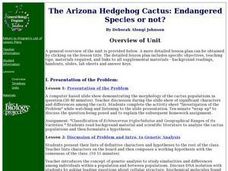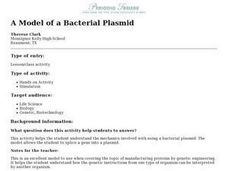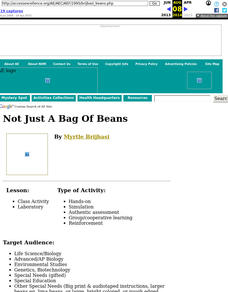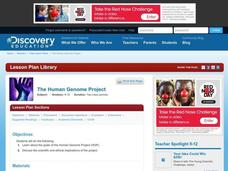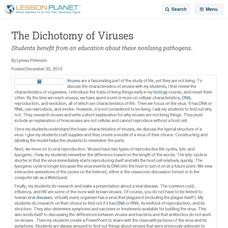Curated OER
Classification Number Two
A three-page quiz assessing budding biologists' understanding of classification. Middle-level learners may need a little additional time on this, but should be able to handle the concepts with ease.
Curated OER
Megabeasts
Create larger-than-life insects for the classroom. Bugs are usually pretty small, but during the Jurassic period they were huge. Kids use diagramming and scale conversion to enlarge a modern day insect so that it is as big as its ancient...
Ask a Biologist
Neuron Anatomy Activity
Reinforce the neural connections in the brains of your young biologists with a simple anatomy activity. Looking at the provided diagram of a neuron, students are asked to correctly identify and describe the function of each of the six...
Novelinks
The Little Prince: Picture Book Strategy
Picture books aren't just for children; they carry strong, valuable messages for adult as well. Explore the audience for Antoine de Saint-Exupéry's The Little Prince with a lesson that compares picture books to literature intended for...
Curated OER
The Arizona Hedgehog Cactus: Endangered Species or not?: Biology, Plants
In this lesson students will study the: "Classification of Echinocereus triglochidiatus and Geographical Ranges of its Varieties." Students read background material and scientific literature to analyze the cactus populations and then...
Curated OER
Inheritance Patterns in Zorks
In this inheritance patterns worksheet, students create a visual of a Zork using chromosome strips to represent alleles from the father and the mother to determine the traits in the offspring. Students translate the genotype to the...
Curated OER
A Model of a Bacterial Plasmid
Students construct a plsmid model with the materials provided and be able to use it to define certain terms and explain other practical applications of genetic engineering. This simulation allows the students to work through the diagram...
Curated OER
Infectious Disease Case Study
Students list the steps an epidemiologist takes to detect a pathogen. They role-play as scientists as they investigate the cause of the outbreak in Japan during 1996.
Curated OER
The Real Eve
Students research about human migration during a specific time period. In this physical science lesson, students watch a video about human evolution. They prepare a presentation on human migration and share it with the class.
Curated OER
Not Just a Bag of Beans
Learners determine the types of natural selection and variation that exists in a population, using beans.
Curated OER
Human Genome Project
Students examine the goals of the Human Genome Project. They research issues of the project such as scientific, potential and ethical implications of the project. In addition, they create a presentation to present their findings.
Curated OER
Translating Genetic Information
Students explore the process of translation. They determine the correct sequencing and present their strands to the class. In addition, they compare normal red blood cells to sickle cells and complete discussion questions.
Curated OER
Human Genes
In this science worksheet, students read 10 statements and 1 question about human genes. Students complete the statements and question by filling in the correct word from a list of 11 words.
Curated OER
How HIV Infects Cells
For this biology worksheet, students answer 2 short answer questions related to HIV based on information provided. They color and label the different parts of a virus.
Curated OER
The Dichotomy of Viruses
Students benefit from an education about these nonliving pathogens.
Curated OER
Genetic Ethics Debate
Students select topics relating to bioethical questions which they research and debate. They, in groups, select topics and are given two to three weeks to research their topics, taking advantage of their school libraries and local public...
Other popular searches
- Dna Replication
- Dna Structure
- Dna Fingerprinting
- Dna Models
- Dna Replication Worksheet
- Dna Sequencing
- Dna Extraction
- Dna Technology
- Recombinant Dna
- Dna Mutations
- Dna Structure Worksheet
- Mitochondrial Dna






